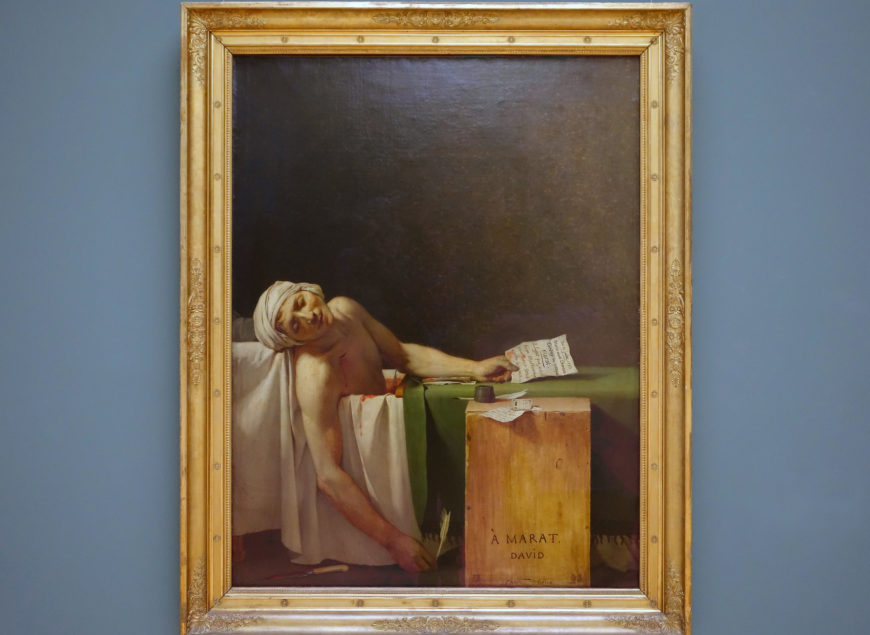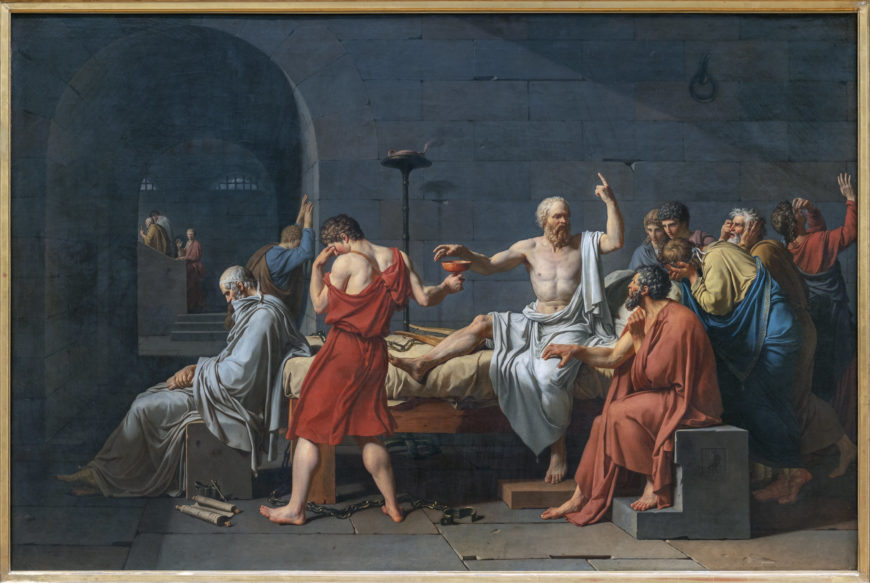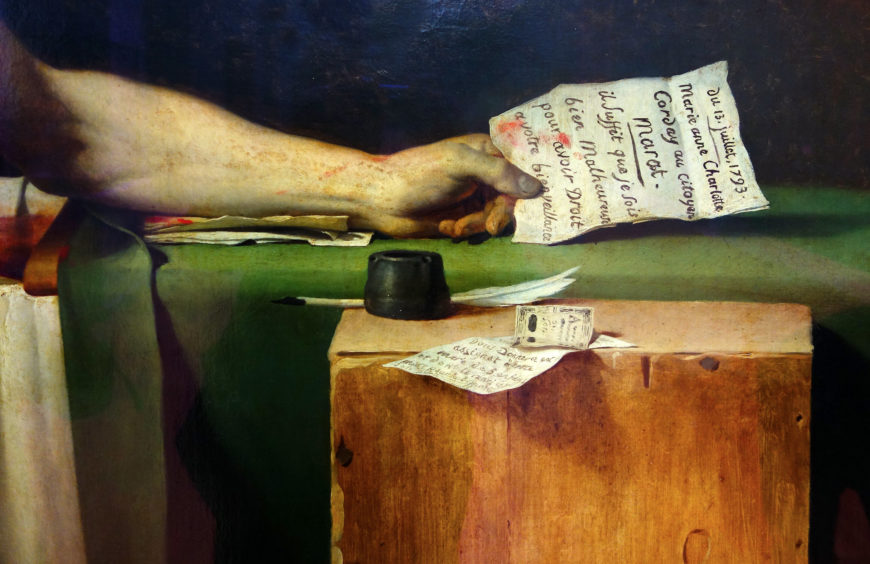Jacques-Louis David, The Death of Marat, 1793, oil on canvas, 65 x 50-1/2″ (Royal Museums of Fine Arts of Belgium, Brussels)
David and the Jacobins
By 1793, the violence of the Revolution dramatically increased until the beheadings at the Place de la Concorde in Paris became a constant, leading a certain Dr. Joseph Guillotine to invent a machine that would improve the efficiency of the ax and block and therefore make executions more humane. David was in thick of it. Early in the Revolution he had joined the Jacobins, a political club that would in time become the most rabid of the various rebel factions. Led by the ill-fated Georges Danton and the infamous Maximilien Robespierre, the Jacobins (including David) would eventually vote to execute Louis XVI and his Queen Marie Antoinette who were caught attempting to escape across the border to the Austrian Empire.

Jacques-Louis David, Death of Marat, 1793, oil on canvas, 165 x 128 cm (Royal Museum of Fine Arts, Brussels; photo: Steven Zucker, CC BY-NC-SA 2.0)
Marat and Christ

Jacques Louis David, The Death of Socrates, 1787, oil on canvas, 129.5 x 196.2 cm (The Metropolitan Museum of Art; photo: Steven Zucker, CC BY-NC-SA 2.0)
At the height of the Reign of Terror in 1793, David painted a memorial to his great friend, the murdered publisher, Jean Marat. As in his Death of Socrates, David substitutes the iconography (symbolic forms) of Christian art for more contemporary issues. In Death of Marat, 1793, an idealized image of David’s slain friend, Marat, is shown holding his murderess’s (Charlotte Corday) letter of introduction.

Detail, Jacques-Louis David, Death of Marat, 1793, oil on canvas, 165 x 128 cm (Royal Museum of Fine Arts, Brussels; photo: Steven Zucker, CC BY-NC-SA 2.0)
The bloodied knife lays on the floor having opened a fatal gash that functions, as does the painting’s very composition, as a reference to the entombment of Christ and a sort of secularized stigmata (reference to the wounds Christ is said to have received in his hands, feet and side while on the cross). Is David attempting now to find revolutionary martyrs to replace the saints of Catholicism (which had been outlawed)?
David and Napoleon
By 1794 the Reign of Terror had run its course. The Jacobins had begun to execute not only captured aristocrats but fellow revolutionaries as well. Eventually, Robespierre himself would die and the remaining Jacobins were likewise executed or imprisoned. David escaped death by renouncing his activities and was locked in a cell in the former palace, the Louvre, until his eventual release by France’s brilliant new ruler, Napoleon Bonaparte. This diminutive Corsican had been the youngest general in the French army and during the Revolution had become a national hero by waging a seemingly endless string of victorious military campaigns against the Austrians in Belgium and Italy. Eventually, Napoleon would control most of Europe, crown himself emperor, and would release David in recognition that the artist’s talent could serve the ruler’s purposes.
Additional resources:
Smarthistory images for teaching and learning:
[flickr_tags user_id=”82032880@N00″ tags=”corday,”]
[0:00] [music]
Dr. Steven Zucker: [0:05] We’re in Brussels, looking at one of Jacques-Louis David’s Revolutionary canvases. This is “The Death of Marat.”
Dr. Beth Harris: [0:13] Revolutionary in two senses. Revolutionary in that it was painted during the French Revolution, which started in 1789. France was made a republic in 1792. David, here, commemorates a hero of the Revolution. It’s also revolutionary in that it’s depicting a contemporary event. Before this, David had painted scenes from classical antiquity.
Dr. Zucker: [0:36] Early on in the Revolution, David had joined the Jacobin Club. This was a group of the most violent and radical revolutionaries. David himself became quite close with the leader of the Jacobins, Robespierre.
Dr. Harris: [0:47] David voted for the beheading of King Louis XVI. His signature is on documents created for the arrest and execution of members of the aristocracy, of people who were against the Revolution. David was really in the thick of it. He served in the Revolutionary government.
[1:06] He helped to dissolve the Royal Academy of the Arts. He was essentially the Minister of Propaganda, spreading the ideals of the Revolution through images.
Dr. Zucker: [1:14] That’s what this is. The Revolutionary government asked him to produce a series of three images that would heroicize new martyrs, not a Christian martyr, but now a martyr to the Revolution.
Dr. Harris: [1:25] This shift from Christian martyr to political martyr is an important one. We have the beginnings of the end of the world of the monarchy, of the ancien régime, of an absolutist ruler, and the beginnings of a new republic, the beginnings of a world where the people participate in the government.
Dr. Zucker: [1:45] The French Revolution had been inspired, at least in part, by the American Revolution just a few years earlier, but France would oscillate between republican and royalist governments over the next century.
Dr. Harris: [1:55] A royalist named Charlotte Corday, a woman who believed in the monarchy, of absolutist rule, went to see Marat, this leader of the Revolution, and, by tricking him, murdered him in his bathtub.
Dr. Zucker: [2:08] You can see the knife which she used to stab him lying on the bottom left corner of the canvas, and the letter that she used to gain entrance being held by Marat. He was a publisher, so his role in the Revolution was important because he helped to disseminate revolutionary ideas and to rally the people.
Dr. Harris: [2:24] He holds this letter that she used to get in to see him. David is showing, “Look at how duplicitous this woman was. She tricked Marat, he was innocent, he was good, he was working for the Republic, for the French Revolution, and she came in and brutally stabbed him.”
Dr. Zucker: [2:38] There is this extreme contrast between her duplicity and his nobility.
Dr. Harris: [2:42] He’s ideally beautiful. We know that he was disfigured by the skin disease that caused him to spend many hours of each day in the bath, but you have no sign of that here.
Dr. Zucker: [2:51] His pose reminds us of the Pietà , of the image of Christ being mourned, having just been taken down from the cross. The idea that a martyr to the Revolution is replacing the central Christian martyr is vividly rendered.
Dr. Harris: [3:05] That was a key idea of the Revolution, to dismantle not only the monarchy, but the church as well, and to secularize French life.
[3:15] We see that also in the creation of a new calendar for the Revolution. Below the signature, David has written “Year Two.” We’re not in 1793, we’re in year two of the Revolution. This whole replacing of the old world with a new revolutionary order, for a new French Republic.
Dr. Zucker: [3:35] The idea of rationalism was being violently instituted. Instead of the older traditional measurements, for example, this is when we first have the more rational metric system being introduced.
Dr. Harris: [3:45] This is the Enlightenment. This is a time of rational thinking, of believing in empirical observation over the superstitions and traditions of the church.
Dr. Zucker: [3:55] This is a painting that is all about observations, this really interesting contrast between the specificity of the foreground, especially the crate on which he’s written his name and written “Á Marat” (“to Marat”) against the indeterminate, open brushwork of the background that almost doesn’t look finished. It’s got this soft, feathery, warm quality.
Dr. Harris: [4:17] It isolates Marat. It focuses our attention on him.
Dr. Zucker: [4:22] As we look around at other paintings in this museum, what I see in the upper part of a painting are angels, and David can’t have that anymore. A new iconography has not yet developed. Instead, what we have is a lighter field in the upper right corner balancing Marat’s body in the lower left corner.
Dr. Harris: [4:40] What a body. The anatomy, the muscles in the shoulder, and the arms, and the collarbone. We can see that Neoclassical interest in studying the anatomy, painting it very carefully, paying a lot of attention to contours, modeling, and the effects of light and dark.
[4:57] What strikes me is the spareness in direct contrast to the luxurious interiors of Rococo paintings, of the lifestyle of the aristocracy which was the subject of Rococo paintings. Here, a decidedly stark interior, spartan, no elaborate furniture, no gold. This is a man, David wants to tell us, [who] lived according to the republican ideals of the Revolution.
Dr. Zucker: [5:25] It looks like they will endure forever, but soon the revolutionaries will turn against each other.
Dr. Harris: [5:30] David is imprisoned for his involvement in the Revolution and then becomes First Painter to Napoleon, who becomes the emperor of France, and so a lot of art historians look at David’s career and say, where were his actual principles?
Dr. Zucker: [5:46] Where were his loyalties?
Dr. Harris: [5:47] Did he truly believe in the ideals of the Revolution, and then become a follower of Napoleon, and abandon those values?
Dr. Zucker: [5:56] Was he politically mercenary? Was he really looking for commissions from whoever was in control at that moment? It’s hard to look at “The Death of Marat” and not see a man who was convinced of the importance of revolutionary ideals.
[6:10] [music]

